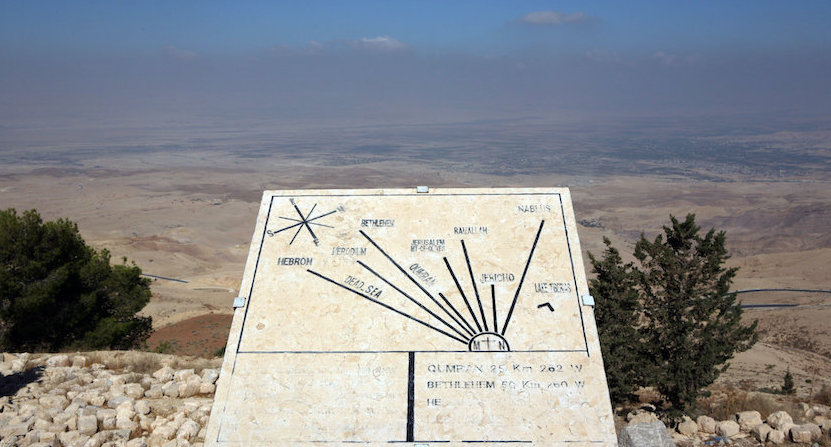Biblical Borders of Israel (part 2)
This article is the second installment of the two-part series. The first article was published in the June issue. You can find this article here.
The Heartland is West of the Jordan
Joshua 22:9-34 reports an interesting event that is relevant in this context. The Israelite tribes of Reuben and Gad and half of the tribe of Manasseh had settled in the East Bank between ‘Arnon and Hermon’. They had built an altar near the Jordan ‘on the border of the territory of Israel’ (verse 11). In the context of the dispute that resulted, the East Bank is strictly distinguished ‘from the land that belongs to the Lord, in which the Lord’s tabernacle dwells’ (verse 19).
If we go back to the south west of the country, the border with Egypt is marked at ‘the river of Egypt’, which is the river Nile, ‘the Red Sea’, the ‘Shihor of Egypt’ or ‘the creek of Egypt’. This ‘brook of Egypt’ is often identified with the Wadi El-Arish, which is located approximately in the middle of northern Sinai Peninsula.
In the time of the Maccabees, the extent of what is today’s modern State of Israel is described fairly precisely when 1 Maccabees 11.59 speaks ‘from the Tyrian ladder’, today’s Rosh HaNiqra, ‘to the border of Egypt’.
The Subjective Reference
Despite this vast amount of border information, it is quite difficult to establish from Scripture a clearly-defined territory for the Promised Land for the chosen people. When we consider the subjective aspect that repeatedly emerges in the environment of biblical statements about the borders of the land, it becomes clear that the Promised Land does not have definitive boundaries.
We find the first border definition of the Promised Land in Genesis 13:14-15. There God tells to Abram: “Lift up your eyes. From the place where you are standing, look to the north, towards the Negev, to the east and in the direction of the sea. All the land that you see, I will give to you and your descendants.”
“What you see, I will give to you!”
A Panoramic View
“What you see, I will give to you!” – It remains unclear exactly where Abram stood when God made this promise, at what time of day, in what season of the year it happened, and what the weather was like. The biblical text leaves the reader in the dark about how good the eyes of the then 75-year-old were. These would have been decisive factors in setting the borders.
With Moses, the biblical tradition is clearer. At the age of 120 years, Moses is not allowed to enter the Promised Land. As with Abraham, the drawing of boundaries is done subjectively from the perspective of the observer. However, it is clear that this is done from Mount Nebo, from one of the peaks of the mountain ridge east of the Jordan River. And it is reported of Moses that “his eyes were not weakened” (Deuteronomy 34:7).
The text also clearly states what Moses sees: From ‘Gilead to Dan’ – that is, the whole mountain range east of the Jordan, including today‘s Golan Heights up to Mt Hermon. ‘All of Naphtali’ – the eastern edge of the Galilean mountains. ‘The whole land of Ephraim and Manasseh and the land of Judah to the sea on the west’ – the central Israeli mountain range with the Shefelah and the coastal plain reaching to the Mediterranean in the background. And then turning left towards the south: ‘The Negev’, the wilderness of Judah, the Dead Sea and right in front of Moses’ feet ‘Jericho, the city of palm trees’ (Genesis 34:1-3).
To Accept As An Inheritance
The personal perspective of Moses, the one who received the promise, based on his relationship with God and his relationship with the land, is decisive for defining boundaries in the Promised Land. This way of thinking also becomes clear when Scripture stresses dozens of times that God gives the land to the people with a mandate, namely, ‘to accept it as an inheritance.’ The Hebrew word yarash is translated as ‘to inherit’, ‘to bequeath’, ‘to take as possession’, ‘to conquer’, ‘to expel’, ‘to settle’, depending on the context.
Connected with the land promise is thus the quite subjective task of entering, inspecting and actively taking possession of the land as an inheritance. This is why the commandment to live in the land of Israel is so important for rabbinical tradition, or, conversely, the ban on leaving the land of Israel.
“If you do not tread the ground, it does not belong to you.”
Stepping on the Land
God had not told Abram much about the land God had promised to him. Only: It is ‘the land that I will show you’ (Genesis 12:1). Decisive for further progress was that ‘Abram went’ (verse 4), that he arrived in the land of Canaan together with his extended family (verse 5) and passed through the land (verse 6).
After Abram had sought peace with Lot by giving him the best part of the Promised Land (Genesis 13:1-12), God repeated His purposes with regard to Abram and his descendants (verses 14-16). Then God gave
Abram the command (verse 17), “Get up! Move through the land in length and breadth, for I will give it to you.”
Several generations and centuries later, Moses described the land that God intended to give to his people by announcing (Genesis 11:24), “Every place the sole of your foot will step on will be yours.” Immediately after Moses’ death, the Lord repeated this instruction to Joshua, the successor of Moses (Joshua 1:2-4): “Get up! Cross over this Jordan, you and all these people, into the land I am about to give to them, to the children of Israel. Every place the sole of your foot will step on, I have given to you as I spoke to Moses.”
In biblical thinking, stepping on the ground determines how big the Promised Land will be. Only that land which the one who received the promise will practically enter and accept as an inheritance by stepping on it, will be the land that God gives him. In reverse, it is true: “If you do not tread the ground, it does not belong to you.”
Thus, King Ahab took possession of Naboth’s vineyard by entering it (1 Kings 21:18-19). And ‘Ploni-Almoni’ ceded his right to the inheritance of Elimelech to the redeemer Boaz by giving him a shoe (Ruth 4:7-8), the very ‘tool’ that enabled him to step on the land. This way of thinking runs through the language of the entire Holy Scriptures.
God has never given his people a land with borders set once for all, a plot of property that would be clearly defined in any land register – and that an ‘Israelite’ residing in New York, Tokyo, Berlin or even Tel Aviv would be able to make work for him from a distance or even exploit it as real estate speculator.
From a biblical point of view, the size of the land and its boundaries depend on the individual’s inspection of the land, and acceptance of it as an inheritance, by stepping on it with the sole of one’s foot. Obedience to the original commission of the Creator to ‘cultivate and preserve the land’ (Genesis 2:15) and a life in accordance with his will emerge as decisive elements considering the borders of the Promised Land.
Republished with permission






